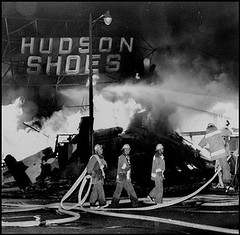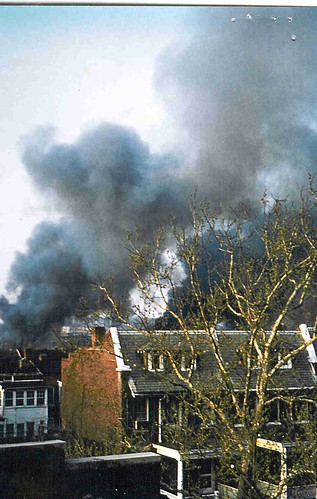Two perspectives on the response to Watts
 A shoe store in the Watts area of Los Angeles, CA, collapses in flames as the city's wave of violence moves into its fourth day, August 14, 1965. (AP Photo)
A shoe store in the Watts area of Los Angeles, CA, collapses in flames as the city's wave of violence moves into its fourth day, August 14, 1965. (AP Photo)Today's Post has an op-ed piece by Roger Wilkins, "The Watts Riots, Burned Into Memory," in response to a Sunday Outlook piece of about ten days ago by John McWhorter, "Burned, Baby, Burned: Watts and the Tragedy of Black America." (Also see the transcript of an online interview with McWhorter, from the Post website.)
Both pieces are provocative, but I think that Wilkins, while he argues that his conclusion is different from McWhorter's, actually makes a similar point:
I agree with McWhorter that the legacy of Watts is a sad one, but I come to a different conclusion. He thinks the energy from that explosion was appropriated by radical reformers lobbying for changes in welfare that ultimately destroyed the moral fiber of poor people and led to the inner-city desolation we experience today.
I believe that while there were both decent, "fed up" people and opportunistic thugs and criminals involved in the rioting, the most important outcome of Watts was that it frightened the wits out of millions of middle-class whites. They fled the cities and city schools and essentially doomed prospects for large-scale urban school integration, while ensuring the erosion of municipal tax bases for a generation. And Watts and the explosions that followed helped fuel a conservative backlash that undermined the massive effort needed to address the problems it exposed.
The Watts legacy is not about tinkering with welfare policy. As the Kerner Commission warned us 2 1/2 years after the riots (a warning soon to be all but forgotten), the problem comes from a place deep inside the American soul. The profound damage done to unlucky blacks trapped in poverty and to whites trapped in indifference or bigotry will still require an enormous amount of sustained American will and decency to correct. That is the real legacy of Watts.
______
McWhorter's thesis is merely a restatement of the work of Fred Siegel, work that I cite often in the guise of the book The Future Once Happened Here. (Both are affiliated with the Manhattan Institute.)
What Siegel calls "dependent individualism" was a response to the "riot ideology" that the unrest occurred in opposition to the oppressive institutions of the white regime. In any case, these responses were designed to ameliorate the likelihood of more rioting. What happened was that municipal institutions, in particular schools, became disconnected from a set of "value-free" standards and objectives oriented to quality. That these institutions often abetted and assisted racism and segregation gave credence to the belief that standards and objectives were merely racist clubs. But the disconnection, which Wilkins discusses, greatly harmed center cities. The discussion in Dream City extends in some respects, Siegel's arguments, specifically about DC.
Wilkins and McWhorter are arguing about different pieces of the same issue. Both must be addressed. An interesting proposal, albeit not "rainbow-oriented," is laid out by Black Commentator in the provocative series Wanted: A Plan for Cities to Save Themselves.
 Smoke from burning H Street. Photo by Kathy Smith, 1968. From the online memoir by Sam Smith, Multitudes, at www.prorev.com.
Smoke from burning H Street. Photo by Kathy Smith, 1968. From the online memoir by Sam Smith, Multitudes, at www.prorev.com.



0 Comments:
Post a Comment
<< Home